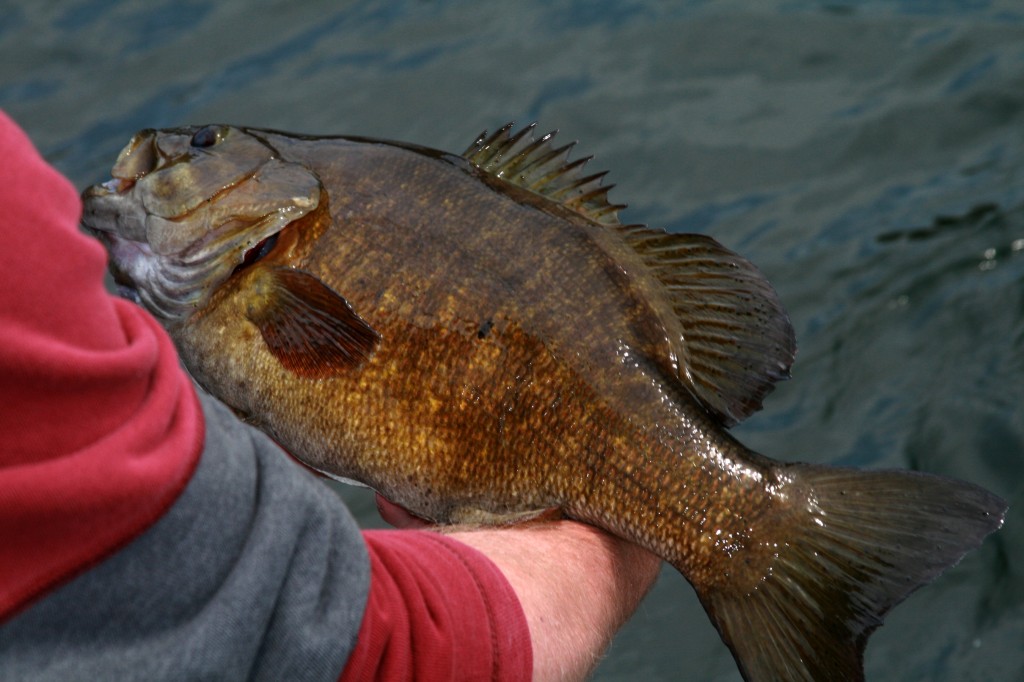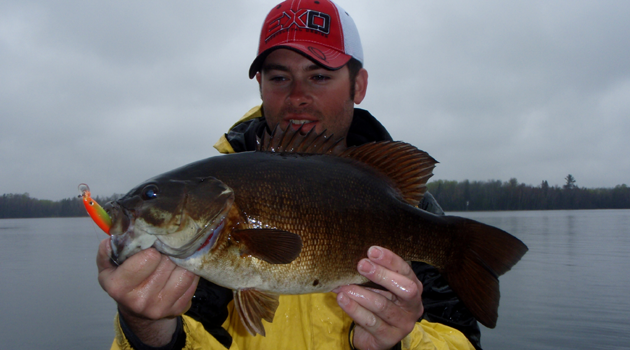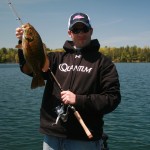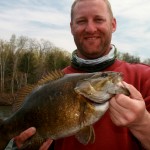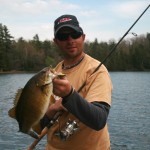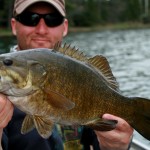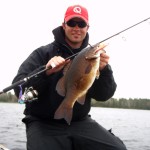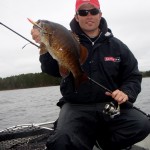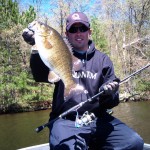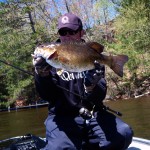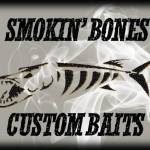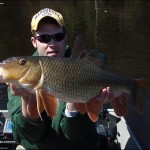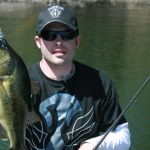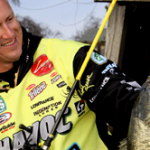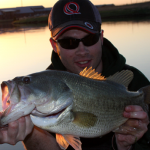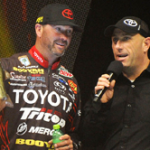By Andrew Ragas
The wind plays a role in determining the outcome of all outdoor sports, including fishing. For smallmouth bass anglers in particular, a wind capable of warming water temperatures plays a significant role in determining early spring fish locations and feeding habits. Precise wind patterns and specific lake locations that conduct heat are instrumental in scoring early season smallmouth success.
A beneficial wind and its corresponding warming water temperatures drive feeding patterns in early spring and wake smallmouths up from their dormant winter state. Anglers who fail to understand wind patterns, and lack a sense of spring smallmouth lake locations, learn to embrace the skunk. Meanwhile those who follow the wind and have learned to use it to their advantage will experience the hot early season bite.
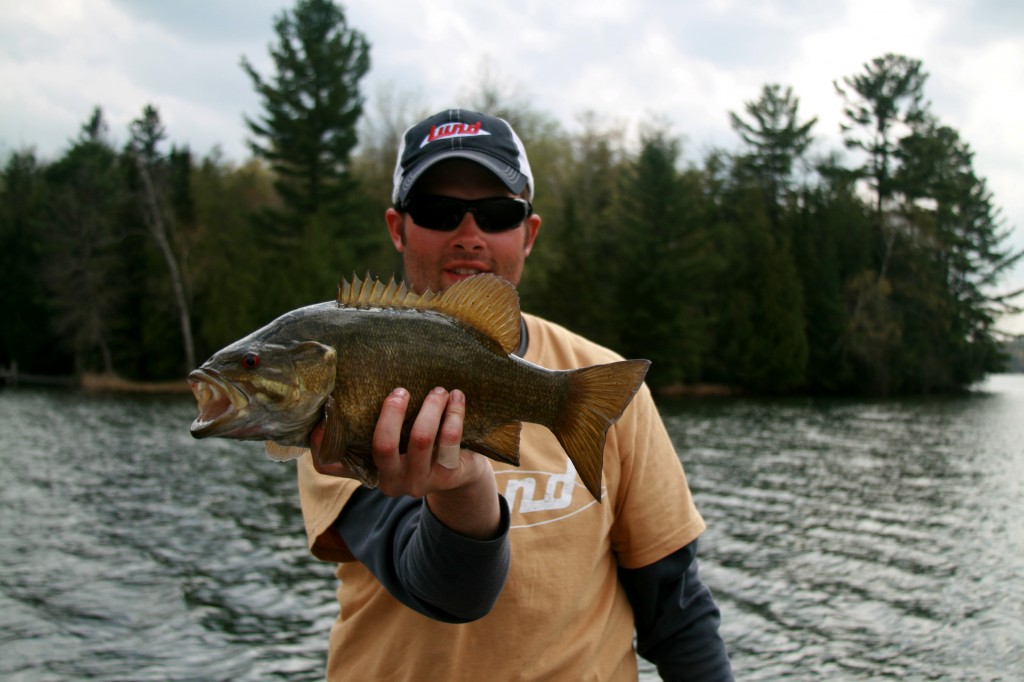
In early season, usually as early as mid-May, once water temperatures crest above 48-49 degrees, my best and most productive smallmouth bites of the year take place on big water. On my inland lakes of Wisconsin, these waters range in size between 1,000 and 5,000 acres and possess a border-line cold water fishery that is home to pelagic ciscoes and few trout. Most bass anglers make errors, believing these waters take forever to warm, thus entirely avoiding them until bass are in the shallows and ready to spawn. Don’t believe what those guys (namely guides) tell you. I’ve learned that avoiding these large waterbodies is a costly error to make. You will miss out on a short window of opportunity for better-than-average smallmouth fishing as more smallmouths in shallow water at this time of year are trophies at this point than at any other time of the year.
When smallmouths leave their wintering holes and begin staging for the spawn, it’s best to be at the edges of rocky shoals and spawning flats waiting for them to arrive. When and where they will show up in the most heavily concentrated wolf packs is determined by wind and the warm undercurrents it creates, and the angle and placement of the sunlight above.
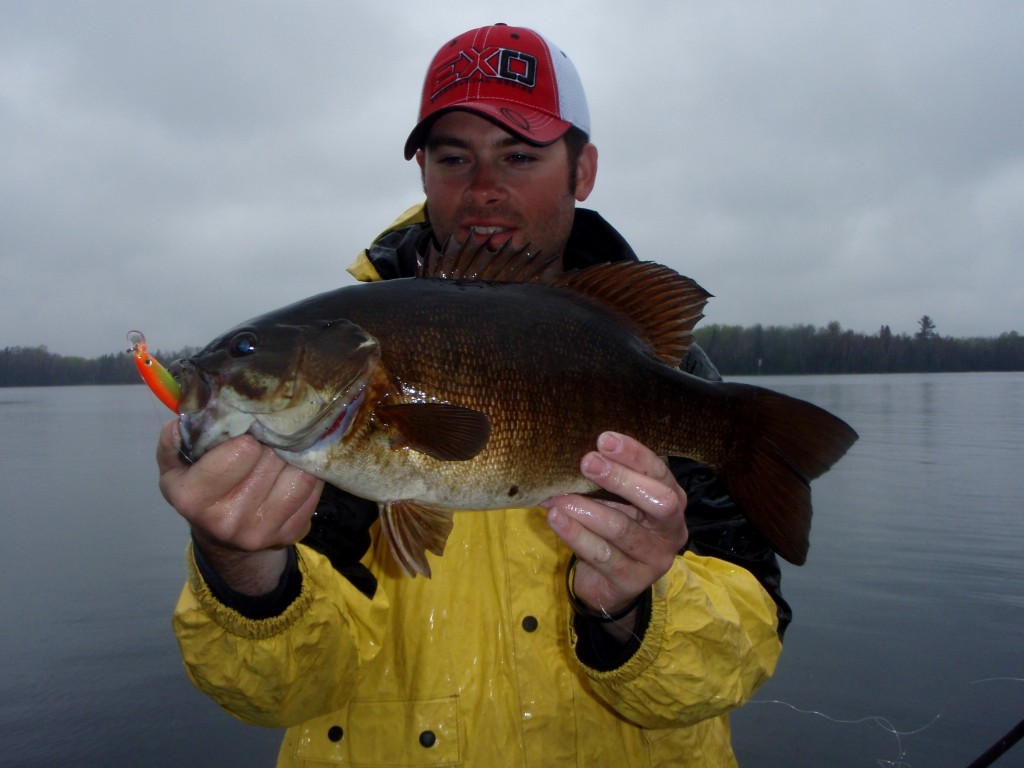
The Spring Smallmouth Movement
In natural lakes, smallmouths winter in moderately deep basins, along the base of main lake points, rock humps and ledges, or out in deep flats that vary between 20 to 50 feet (all depending upon the lake). It’s noted how ritualistic smallmouth bass are, thus they will often return to the same spawning sites and feeding flats year after year. Because of these characteristics, a sense of location and understanding of the lake’s topography is critical.
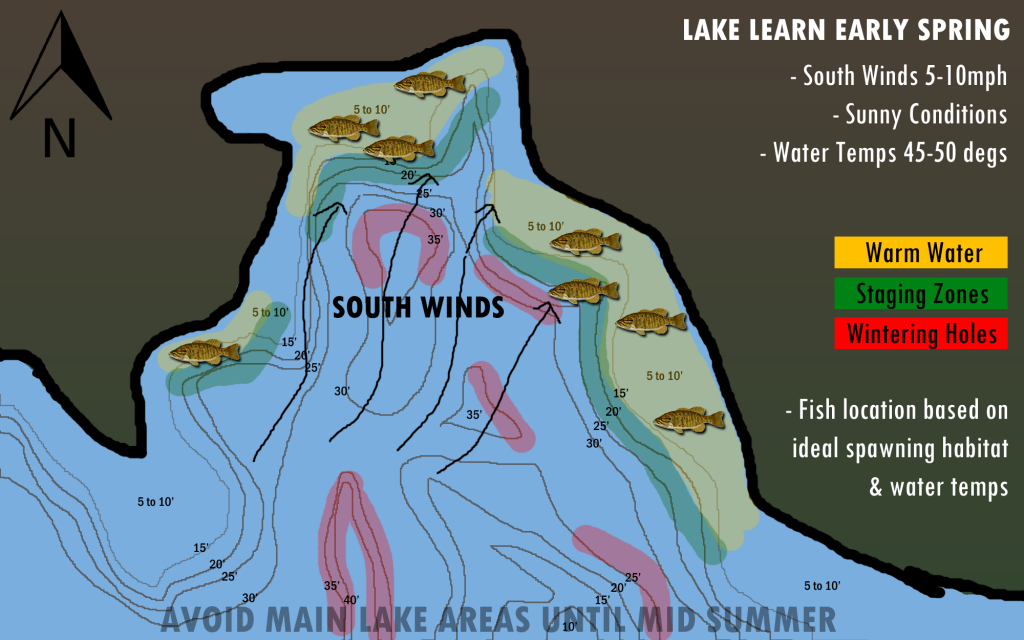
When smallmouths rise up from their wintering holes is determined by water temperature, which is heavily influenced by sunlight and wind direction. It’s like clockwork, basically. When the water temperature hits a certain number, fish will rise from these habitats, and follow a trail of underwater structure to the shallows they will be using for feeding and spawning.
Many of my favorite and most productive smallmouth lakes contain multiple staging areas, sometimes dozens, where fish show up early in spring. Most successful anglers know the spots that will turn on first will be those that warm the fastest. The areas that warm quickest are determined by underwater structure and the lake’s geography. Typically, shallow bays with exposure to the southern skies will warm the fastest unless a north wind is blowing all of that warm water back out towards the open basins of the lake.
On my waters, wind direction usually determines where the hot bites will take place. The success of the wind pattern depends on several factors which includes air temperature, sunlight penetration, wind speed, rainfall, and under-currents beneath the water’s surface.
Big water that takes forever to warm in spring is intimidating for the simple reason that much of the surface acreage of the lake is deep and still cold. It’s possible to make predictions about how good or bad a spot on a specific lake might produce without having to travel there. However, one will never know without launching the boat and burning gas to get there.
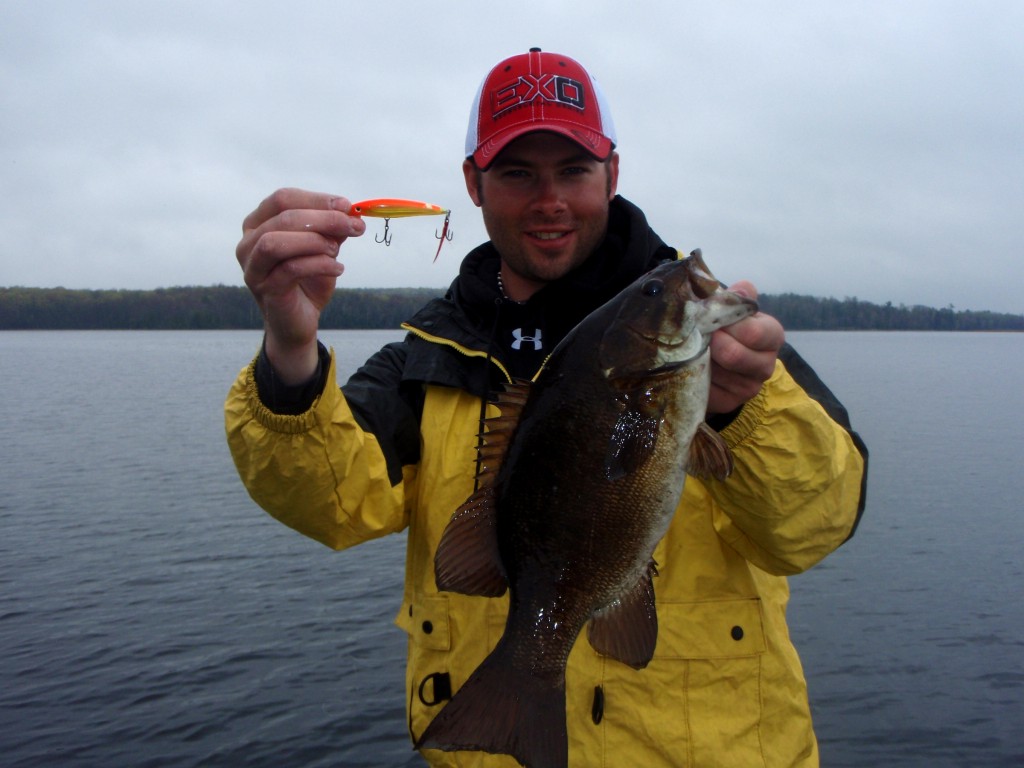
Wind Strategies
In May of 2013, within a week following a late ice out, my partner Jacob Saylor and I spent an entire day fishing on a thousand-plus acre lake that has historically fished well for me in early season and produces numbers of 3 to 4 pounders. With the ice melt a week earlier, we didn’t know how it would fare. Throughout the day’s first half, it uncharacteristically didn’t fish well. From 7 am, when we launched the boat, through 12 noon, water temperatures barely crested 47 degrees and we did not catch a single fish other than a few accidental walleyes that were still in midst of spawning. By then, we had already done a tour of the lake and had no idea what was going on.
Poor Jake was losing his patience while I kept calm and was the confident boat presence we needed. I knew it would be an abnormally slow outing until the sunlight finally worked its spring magic, and wind speed and direction had enough positive effect on surface temperatures. I gave him the option we could leave the lake and miss out on the potential hot afternoon bite. But by doing so we would have to go through the process of re-patterning a new lake that likewise hadn’t warmed yet or peaked during the day. He took my suggestion that we erase the memory of the miserable morning, and that we remain on the lake because I observed the weather influencing the lake in a positive way and the temperature gauge of my Lowrance Elite 7HDI climbing. The day was quickly warming.
A westerly 5-10 mph wind had shifted to a very warm wind of similar speed from the south. Additionally, air temperatures ballooned from a cold 50 degrees to a humid 70 degrees. The power of sunlight was finally burning off the cloud cover and penetrating through the water. Slowly but surely, water temperatures were finally on the climb and peaked during the afternoon at 50 degrees. With winds blowing from the south, and a large shallow rocky and sand spawning flat located up in the lake’s far northern end that we had already fished unsuccessfully earlier in the morning, we raced back over there again for a re-do. Like clockwork, the smallmouths moved in from the nearby deep water and responded to our Rapala X-Raps. Likewise, we patterned other similar areas of the lake with equal success. The south wind and its accompanying warm front was the required catalyst for our 40 fish afternoon and the feeding frenzies we experienced.
By fishing big water like this, I learned some important lessons. Never create a complex game plan the night before or morning of. The best plan is to wait until launching the boat, and allowing the weather and its wind patterns to dictate technique, and the locations you will fish.
Wind Influence and Locations
An early spring wind fishes best when the sun is shining. When wind is blowing inward and sunlight is present, the water will warm along shorelines and in shallow bays adjacent to deep water. By keeping track of wind history and its effect on specific spots, it’s possible to predict the locations of the lake where water will be warming. Wind creates currents. For instance, if the wind has been blowing from the west for 24 hours or more, there is a possibility that the rocky shoals and spawning flats facing west will most likely be the warmest and have the most active fish. Likewise, if wind is from the east or another direction, the opposite will be true assuming the weather and water temperatures remain on the warming trend.
Wind affects how much sunlight penetration the lake receives. Any warm wind is excellent, but the best is one that allows the sun to work its magic too. When sunlight hits specific pieces of structure and reflects off certain bottom types, the surrounding area will bake and warm rapidly. I generally reference these areas as “microwaves”. Every lake I fish for smallmouths is full of these unique spots and they are nothing more than natural heat conductors that can only be found on your own. Good heat conductors to key in on throughout early spring are shallow sandy spawning bays (north and east shorelines best), sand flats, rocky shoals, boulders, downed wood, and windblown shorelines that are exposed to sunlight. Many smallmouth fishermen whom I get to converse with make the mistake of believing that mud bottomed bays are ideal too. For early season smallmouths they are a non-factor as they do not conduct any heat whatsoever.
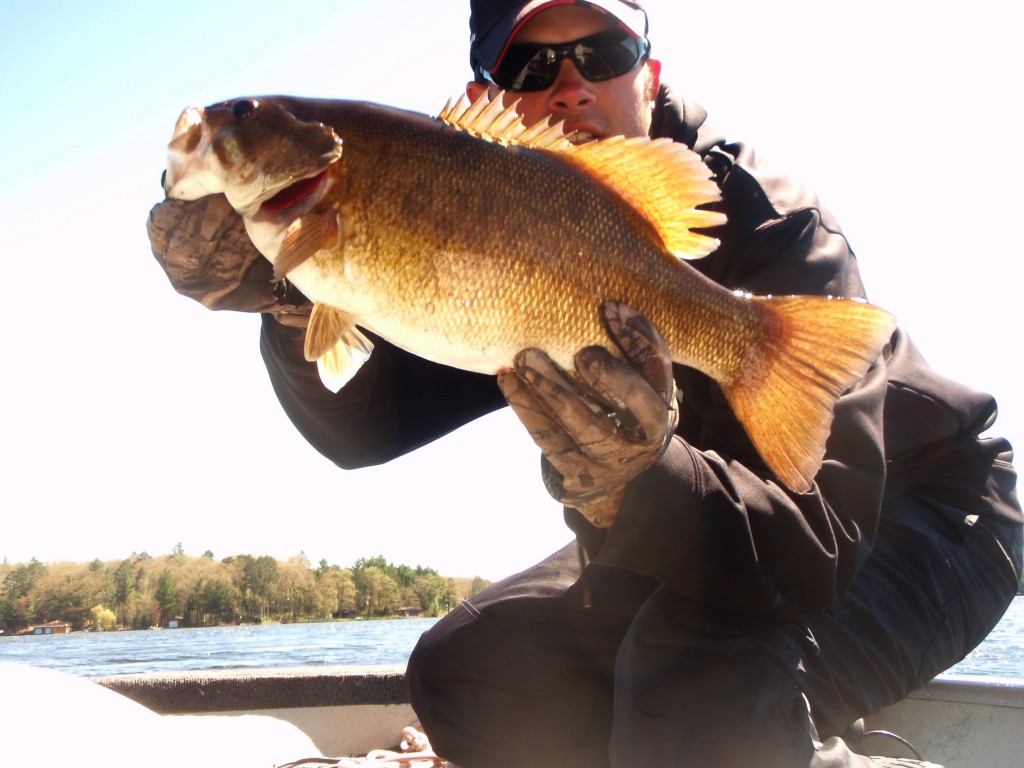
Big smallmouth caught from sunlight exposed spawning flat and staging area.
Plans and Presentations
On my big lakes each spring, both baitfish and smallmouths are looking for the warmest water they can find. In water temperatures between 40 and 57 degrees, smallmouth bass movements are nothing more than foraging movements that are associated closely to nearby spawning areas. In early spring, the best feeding window peaks at 50 to 56 degrees.
On these big waters, it becomes crucial to gather as many key spots all over the lake and to plot out a milk run of spots that can be reached and revisited repeatedly throughout the day. Once on the spot, follow your electronics and gauges closely. If the water is warming, stick around and camp on the spot for as long as necessary, especially if the spot produces annually. If water remains cool, move onward to the next spot.
Following the warm winds of spring is a strategy that will direct you towards windward shores with more waves. Just about everywhere I fish in spring, smallmouths will often take a suspending jerkbait. It works great in wind.
Suspending jerkbaits catch early spring smallmouths better than most other baits I throw. Part of it is through technique while most of it is due to their capability to freeze in space and hover in the faces of fish. Since jerkbaits seem to outfish other artificial minnowbaits by a wide margin in spring, I can only speculate that suspense and rattles are at the forefront of its success.
My favorite jerkbait and smallmouth lure of all time is the Rapala X-Rap in sizes 08 and 10. I’ve written extensively about them but never in an early spring themed article. They work in most situations, allow for long casts and maximum water coverage, trigger active and inactive fish, and suspend the best of any bait in its class. Smallmouths respond to the pause about 99% of the time. They suspend perfectly, and work best when worked progressively faster as the water warms and when retrieve is catered to the activity level and feeding moods of fish. Color choice is purely optional as I’ve caught smallmouth on almost every color in its lineup. But if I were to select, my best producers are hot head (yellow and orange), moss chartreuse shad, albino shiner, purple gold, and rusty crawdad.

Other jerkbaits are similarly productive in cold water, and tend to become increasingly effective when a specialized presentation is required. One particular jerkbait I introduced to my lineup in 2013 is the 4 inch Matzuo Phantom Minnow. This 3/8 oz jerkbait with oversize internal rattle system is meant for substantially slower fishing. It fares better than the X-Rap when faced with coldfronts and cooling trends, inactive fish, and larger concentrations of staging fish when they are really stacked and covering water isn’t required.
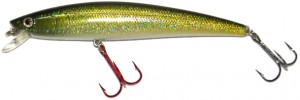
A great number of jerkbaits are available on the market today through the super retailers. There are several other brands that I can mention but don’t have the space. It pays to experiment, because as you become proficient with this wickedly successful style of early spring smallmouth fishing, you will come to learn that each specific jerkbait in the box will serves a specific function.
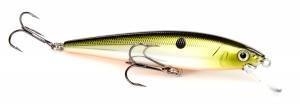
Along with specialized lures, rods and reels for jerkbait fishing are also becoming more specialized for these techniques also. For this type of fishing, I strongly recommend a spinning rod and reel over a baitcasting set-up. A 7 to 7 ½ foot medium heavy fast action spinning rod (Quantum Tour Edition or Superlite) with a large capacity reel (Quantum Catalyst size 30) spooled with 8 or 10 pound copolymer line (Cortland Camouflage & Endurance) allows for exceptional casting distances, faster retrieves and reactionary time, and generates more power and greater jerkbait action which all baitcasters fail to produce. Line is also important. Some folks will use braided superlines with fluorocarbon leader material but I strongly don’t recommend it. The name of this game is suspending the bait and keeping it within 5 feet below the surface at all times. Braided lines float and fluorocarbon leaders sink, offering zero line control. They also don’t offer any stretch which is needed for really good hook sets. I’ve seen anglers lose more fish and miss many more opportunities fishing this way than they would with copolymer lines.
Since early spring presentations such as jerkbait fishing must be slow, subtle, and controlled, use the wind to your advantage when casting and covering water. Keep the wind behind you as often as possible and use the trolling motor to adjust casting angles. Early season smallmouths tend to move onto their shoals and spawning flats in pods and sometimes in heavy concentrations. Fan cast these areas in order to locate them. The key to catching early season smallmouth bass like this is to have a wind-based strategy. It’s always tempting to cover as many spots as possible to maximize productivity but in early spring it’s unnecessary. Most early season trophy smallmouth will be scored from specific spots on the big lake where the water is warmest.
